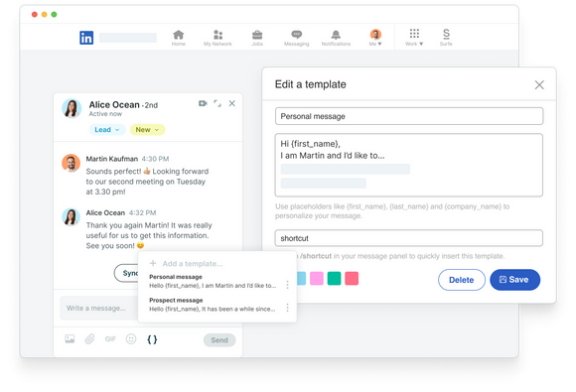How to warm up cold outreach

While the once popular method of cold outreach is slowly dying, this doesn’t mean you have to completely revamp your sales approach.
If you’ve ever had someone hang up on you right after saying hello, you’re not alone. Or maybe it’s a cold email that gets deleted without even being opened.
In the modern day, we receive so many spam messages that it’s increasingly difficult to distinguish between what’s worth our time and what’s not.
Keep reading to learn about modern selling techniques that can be used to warm up your cold outreach.
Why is cold outreach dead?
Cold outreach is defined by contacting a person before a relationship has been built, with the intention of making a sale.
While email campaigns have maintained their popularity over the years, much of prospect outreach has moved away from phone calls and online to LinkedIn.
The shift away from cold calling can be attributed to many things, but stems from a shift in consumer attitudes and buying patterns.
With all of the technology available at our fingertips, consumers need time to collect information about a product or company before investing to ensure that there are no better alternatives.
Cold calling requires an immediate response that most consumers are just not ready to give, oftentimes turning them away from the idea of investing altogether.
The approach often comes off as too invasive, which is why so many people will hang up a call before taking a chance to listen – making cold outreach highly susceptible to missed opportunities.
How to defrost your cold outreach strategy
1. Prospect with a purpose
We know it can be tempting to use automation tools to retrieve long lists of leads, but to increase your output of warm leads, remember quality over quantity.
In other words, don’t send a bulk campaign to every contact you come across, because your messages will surely be regarded as spam if they serve no purpose to the individuals you are targeting. Also, people are usually aware of when they are being sent mass marketing messages which will significantly reduce the likelihood of a response.
By focusing on those that match your user personas, you can allocate more time towards tailoring the message to your prospects’ specific needs – ultimately yielding more conversions in the long run.
We call this “prospecting with a purpose.”
2. Hook them with the subject line
So you’ve found the contact information for prospects who fit into your target audience, but what’s next?
Here is where we make the first outreach.
Don’t forget that you are trying to sell something, so your subject line must be catchy. We’re all familiar with those gimmicky subject lines such as “Look what we’ve got in store for you!” or “We know you’ll love this.”
These are the kinds of messages that usually get deleted before being opened, so try saying something that is specific towards what you have to offer.
When writing your email or message, keep in mind the pain points of the person you are trying to reach.
For example, IKEA sent out an email with the headline “Where do all these toys go?” By asking a question, they are engaging the prospect and appealing to the pain point of having a messy house. In doing so, they are simultaneously encouraging the recipient to solve this problem by purchasing storage equipment at IKEA.
3. Personalization is key
Although you want to come off as persuasive in your header or subject line, don’t try to initiate a sale on the first contact or else your message will be considered cold outreach. Instead, use personalization to nurture the relationship until you feel comfortable that your prospect is ready to buy.
We know you probably don’t have the time to write a unique message for every person that you reach out to, but try to address them by name at the very least.
Your leads will be much more likely to show interest if they have the impression that you took the time and effort to contact them personally instead of sending out an automated message.
It’s all about making your prospect look and feel like the center of attention.
If you would like to incorporate personalization into your LinkedIn outreach but don’t want to add another task to your to-do list, try using Surfe’s (ex-Leadjet) smart messaging templates. The LinkedIn integration allows you to create customized messages with placeholders for information such as name and company – which will automatically fill when you initiate contact with someone on LinkedIn.

This feature is not only a huge time-saver, but has also helped companies like Havr to achieve a 92% reply rate.
4. Wait until your prospect is ready
You’re probably wondering – if I don’t make a sale on the first attempt at outreach, what in the world am I supposed to say to a stranger?
Well, we’ve already answered this question earlier on in the article. Focus on your prospect’s pain points.
Acknowledge that you’re aware of a problem or issue that they might be facing, because let’s be honest – who isn’t interested in finding a solution to one of their obstacles?
Don’t just stop at the headline or subject line, but weave this tactic throughout the body of your message(s) until the conversation evolves to a point that you’re ready to make a sales pitch.
We also recommend using informal language which very subtly takes the “sales” out of the pitch.
Prospective customers are more likely to convert when they have the feeling that you are genuinely interested in helping them, rather than trying to meet your monthly sales quota.
Lastly – don’t forget that your prospects are human too.
According to Microsoft, the human attention span is about 8 seconds, meaning that longer messages are not necessarily more efficient. Keep this in mind and use brief sentences when possible.
5. Adopt a multichannel approach
The best way to continuously nurture your prospect without imposing a sale is to position yourself so that they can’t forget about you.
This means investing time in their satisfaction, even if there is no immediate benefit for you.
Add them on social media, warm them up with new content, host webinars, invite them to subscribe to your newsletter, or even try launching a targeted ad. If you have a discount code, downloadable asset, or anything else that will appeal to your prospect without forcing a sale on them, that’s an extra bonus!
Show them that they are valuable to you whether they are a paying customer or not.
In turn, you will stay on their radar and be the first one in their consideration set – if and when it’s time to buy.
Bottom line
The first contact you make with someone is the most important, because there aren’t many opportunities to redeem yourself after.
If your response rates haven’t been quite as high as you would like or you are simply looking for a way to modernize your outreach approach, these 5 tactics will lead you in the right direction.
It’s crucial to adapt your sales strategy alongside the perpetually evolving landscape, and warming up your cold outreach from the very top of the sales funnel is the best place to start.


